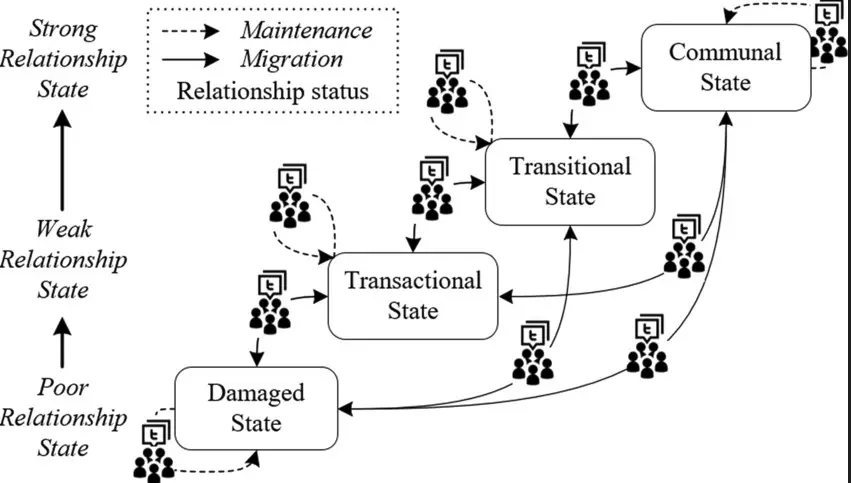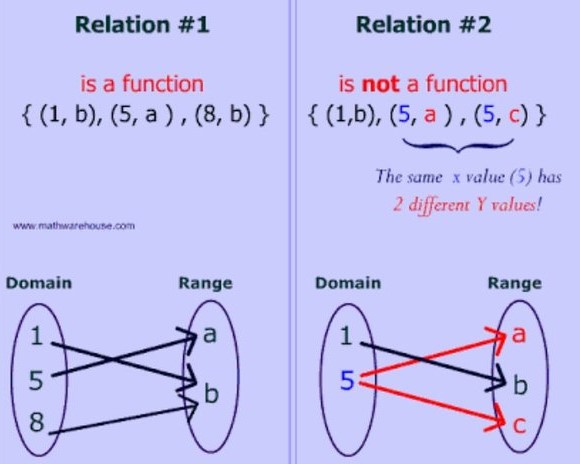Mathematics, a universal language, offers clarity and precision in understanding the world around us. Central to this discipline are the concepts of functions and relations, foundational elements that describe the relationship between sets of information. Each serves as a cornerstone in various mathematical and practical applications, from simple equations to complex models in science and engineering.
The difference between a function and a relation primarily lies in their definitions and constraints. A relation is any set of ordered pairs, whereas a function is a specific type of relation where each input is related to exactly one output. This distinct characteristic of functions ensures a unique mapping from elements of the domain to elements of the range, a property not necessarily held by all relations.
Diving deeper, these concepts are not merely academic exercises but tools that model real-world phenomena. Functions, with their definitive one-to-one or many-to-one relationships, offer predictability and specificity in outcomes, crucial in fields like physics, economics, and computing. Relations, encompassing a broader spectrum of associations, allow for the exploration of connections between data sets, leading to insights across mathematics and beyond.

Basic Concepts
What is a Relation?
Definition and Examples
A relation in mathematics describes a connection between sets of information. Specifically, it involves pairs of items, where the first item is from one set (called the domain) and the second is from another set (called the range). For instance, consider the relation “is the capital of” between the set of cities and countries. Paris related to France is an example of a pair within this relation.
Types of Relations
Relations can be classified into several types based on their characteristics:
- Reflexive: Every element is related to itself.
- Symmetric: If �a is related to �b, then �b is related to �a.
- Transitive: If �a is related to �b, and �b is related to �c, then �a is related to �c.
- Equivalence: Combines reflexive, symmetric, and transitive properties.
What is a Function?
Definition and Examples
A function is a special type of relation where each element in the domain is associated with exactly one element in the range. For example, in the function �(�)=�2f(x)=x2, for every input �x, there is a unique output �(�)f(x). This characteristic ensures a specific output for each input, unlike general relations which might map a single input to multiple outputs.
Function vs. Other Mathematical Mappings
Functions differ from other mathematical mappings primarily in their uniqueness of association. While relations can have multiple outputs for a single input, functions maintain a one-to-one or many-to-one relationship between domain and range elements.
Core Differences
Definition and Structure
Comparing Definitions
The key difference in definitions between a function and a relation is that a function, by definition, associates each input with exactly one output. This constraint is what distinguishes functions from broader relations.
Structural Differences
Structurally, functions require a unique mapping for each input, whereas relations may include multiple outputs for a single input. This structure impacts how functions and relations are utilized and analyzed in mathematics.
Representation Methods
Graphical Representation
Graphical representations of functions and relations can illustrate their differences:
- Functions are graphed so that each �x-value on the horizontal axis corresponds to exactly one �y-value on the vertical axis.
- Relations might show multiple �y-values for a single �x-value.
Algebraic Expression
Functions often use algebraic expressions to define the relationship between variables, such as �(�)=2�+3f(x)=2x+3. Relations can be more complex, potentially lacking a single formula to encompass all pairings.
Mapping Diagrams
Mapping diagrams for functions show each input connected to a single output. In contrast, diagrams for relations may illustrate one input linked to multiple outputs.
Types and Examples
Types of Functions
- Linear: Direct proportionality between variables.
- Quadratic: Parabolic relationship, represented by �(�)=��2+��+�f(x)=ax2+bx+c.
- Exponential: Growth or decay at a consistent rate.
Types of Relations
- Reflexive: Self-linkage.
- Symmetric: Mutual linkage.
- Transitive: Sequential linkage.
Real-world Examples
- Function: Distance traveled over time at a constant speed.
- Relation: Siblings, where one person can have multiple siblings.
Functional and Relational Properties
Domain and Range
Explanation and Significance
The domain of a function or relation is the set of all possible inputs, while the range is the set of all possible outputs. Understanding these concepts is crucial for analyzing and applying functions and relations.
Differences in Context of Functions and Relations
For functions, each element in the domain maps to exactly one element in the range. Relations may not adhere to this rule, allowing for a more diverse range of associations.
Uniqueness and Mapping
One-to-one vs. Many-to-one
- One-to-one: Each input maps to a unique output, and vice versa.
- Many-to-one: Multiple inputs map to the same output, common in functions but not in one-to-one relations.
Role in Differentiating Functions and Relations
The concept of uniqueness in mapping plays a critical role in distinguishing functions from relations. Functions’ requirement for each domain element to map to a single range element underlines their deterministic nature, setting them apart from the more flexible structure of relations.
Practical Applications
In Mathematics
Problem-solving
Functions and relations are vital tools in mathematical problem-solving. They enable mathematicians to model relationships between variables, facilitating the discovery of solutions to complex problems. For instance, functions can model the trajectory of a projectile, allowing for predictions about its path and final location. Relations, on the other hand, help in understanding associations between sets, such as the equivalence relation, which groups elements into partitions or classes with common features.
Theoretical Implications
The study of functions and relations has deep theoretical implications in mathematics. Functions, with their well-defined behavior, are the backbone of calculus, analysis, and many areas of applied mathematics. They are crucial in defining continuity, limits, and derivatives, forming the basis for understanding change and rates of change. Relations extend this understanding by providing a framework for exploring equivalences, orderings, and networks within and across mathematical structures.
In Real Life
Science and Engineering
In science and engineering, functions and relations are applied to model and understand natural and designed systems. Functions, for example, are used to describe physical laws, such as Newton’s law of gravitation, which relates the force between two objects to the product of their masses and the inverse square of their distance. Relations find applications in circuit design and systems engineering, where the interaction between components can be described in terms of inputs and outputs, dependencies, and feedback loops.
Economics and Social Sciences
Functions and relations also find applications in economics and social sciences. Functions are used to model economic behaviors, such as supply and demand curves, where the price of an item is functionally related to the quantity supplied or demanded. In social sciences, relations help to map social networks, understanding the connections between individuals or groups and analyzing patterns of influence, relationships, and social structure.
Common Confusions
Misinterpretation of Graphs
Identifying Functions from Graphs
A common confusion arises when attempting to identify functions from graphs. The vertical line test is a simple method to determine if a graph represents a function: if any vertical line intersects the graph at more than one point, the graph does not represent a function. This test emphasizes the fundamental requirement that in functions, each input (or �x-value) corresponds to exactly one output (or �y-value).
Common Pitfalls
Common pitfalls in graph interpretation include overlooking multiple points along a vertical line or misjudging continuous versus discrete data. For instance, a set of discrete points might pass the vertical line test, indicating a function, while a continuous curve that doubles back on itself would not. Understanding the nature of the data and the context of the graph is crucial to avoid misinterpretation.
Misuse in Terminology
Clarifying Common Misconceptions
Misuse in terminology often leads to confusion between functions and relations. A common misconception is that all relations are functions. Clarification comes from recognizing that while all functions are relations (specifically, relations with a unique mapping from inputs to outputs), not all relations meet the criteria to be considered functions.
Correct Usage in Academic and Practical Contexts
Correct usage of terms is essential in both academic and practical contexts. In academic settings, precise language supports clear understanding and communication of mathematical concepts. In practical applications, accurate terminology ensures that models and analyses are correctly interpreted and applied. For example, describing a relationship as a function in a scientific study implies a level of predictability and specificity in outcomes that may influence research methods and interpretations.
Functions and relations serve as fundamental concepts in mathematics, underpinning a vast array of theoretical and practical applications. Their study not only enriches our understanding of mathematical relationships but also equips us with tools to model and analyze the complexities of the world around us. From the precision of scientific research to the analysis of economic trends and social networks, functions and relations offer a framework for understanding and influencing the natural and social worlds. In bridging the abstract and the applied, these concepts demonstrate the power of mathematics to illuminate patterns, predict outcomes, and solve real-world problems.
Frequently Asked Questions
Can a relation be a function?
Yes, a relation can be a function if it meets the specific criterion that every element of the domain is associated with exactly one element of the range. This means each input value maps to a single output value, adhering to the definition of a function within the framework of relations.
How do you identify a function from a relation?
To identify a function from a relation, examine whether each input (or domain element) maps to only one output (or range element). If any input corresponds to more than one output, the relation is not a function. This can be determined through graphical tests, such as the vertical line test, or by analyzing the set of ordered pairs for unique first elements.
What makes a function different from a general relation?
The key difference between a function and a general relation lies in the uniqueness of mapping. In a function, every element of the domain is paired with exactly one element of the range, ensuring a unique correspondence. In contrast, a general relation may associate a single domain element with multiple range elements, lacking this constraint.
Why are functions important in mathematics and real life?
Functions are crucial both in mathematics and real life for their ability to model relationships where each input is connected to a precise output. This predictability and specificity enable the formulation and solution of problems in various fields, including physics, engineering, finance, and computer science, making functions indispensable tools for analysis and prediction.
Conclusion
Understanding the distinction between functions and relations enriches one’s mathematical literacy, fostering a deeper appreciation for the structures that underpin both theoretical and applied mathematics. It lays the groundwork for further exploration and mastery of mathematical concepts, opening doors to sophisticated analyses and problem-solving strategies.
Moreover, this knowledge transcends academic boundaries, equipping individuals with critical thinking and analytical skills applicable in diverse real-world contexts. The ability to differentiate between functions and relations is not just a mathematical exercise but a fundamental component of logical reasoning and intellectual inquiry.

